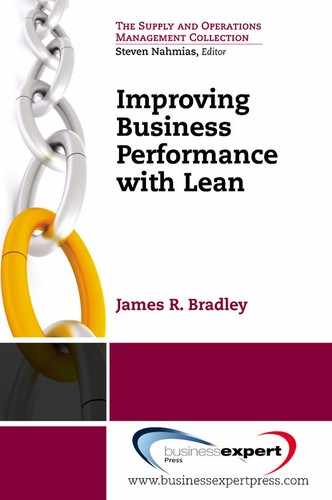A Framework for Applying Lean
Many structured approaches exist for improving processes and solving problems. The Plan, Do, Check, and Act (PDCA) approach has existed for a long time. Define, Measure, Analyze, Improve, and Control (DMAIC) is used with the Six Sigma methodology. Lean uses a similar approach, although no acronym is usually associated with it. The steps are as follows:
- Map the process, thereby creating the current state value stream map.
- Analyze the current state value stream map looking for unnecessary lead time and possible ways to reduce that wasted lead time using Lean tools.
- Draw the value stream map that reflects ideas for improving the process and reducing its lead time: This is called the future state value stream map.
- Determine from the future state value stream map how much lead time can be reduced.
- Create a priority list that reflects the order in which the planned improvements will be made.
- Implement the improvements and check how much the process lead time (and other metrics) has improved and whether the improvement met expectations.
- Institute the improved process by standardizing on it and expecting adherence to the new process definition.
- Repeat the steps above indefinitely.
Many types of maps can be used to map processes. The type of map used in Lean is called a value stream map (VSM), and we will describe how to create one in the next chapter. We will also describe in that chapter how to analyze the process, via its map, to measure lead time and other process metrics. Part II of this book surveys some of the tools that are used within the Lean framework and how they reduce lead time and improve other business metrics. In chapter 5, we also discuss the necessity of standardizing processes if process performance is to be improved. The last step in the list indicates that Lean is a continuous improvement process: Addressing a process just once with Lean does not reveal all the possible improvements. Processes can be analyzed and improved many times with Lean. The initial application of Lean addresses gross inefficiencies, and only after they are resolved can the minor inefficiencies be noticed and addressed. Even if lead time is reduced 70% to 90% in the initial application of Lean, improvements of the same order of magnitude can be made in the second and third applications.
The Lean framework outlined previously is similar to PDCA and DMAIC in that, first, the effort begins by measuring the process. Lean, like Six Sigma, is a data-driven methodology: Improvements are not based on hunches about how the process is executed, and it is not assumed that prospective changes in the process will actually result in improvement. Rather, time is spent to understand the process, map it, and analyze it, resulting in a high degree of confidence that the improvements identified will be successful. Thus both Lean and Six Sigma have an analysis component. All the process improvement frameworks end with the fix being institutionalized: If it cannot be guaranteed that the fix will continually be applied, then it cannot be guaranteed that the process will be improved.
Lean borrows a vast majority of its tools and terminology from the Toyota Production System (TPS). One tool that is used in Lean that is not part of the TPS repertoire is value stream mapping. Value stream mapping is an essential tool, however, because it is the mechanism that is employed to gain an overall understanding of the process and to point out where Lean tools can be implemented to the greatest advantage. To the contrary, process improvement in TPS is usually discussed in terms of its tools directly applied to problem areas rather than employing this overarching guiding mechanism. Value stream mapping is also advantageous because it brings about a great amount of awareness about how the process is really executed. Until such a map is created, no one person in a company is cognizant of how things are accomplished: Each person might know what role he or she plays in the process, but nobody knows the whole process or how the process steps interact. Furthermore, it is also often true that individuals cannot recite the sequence of tasks they follow to play their role in a process without thoughtful reflection, which can be motivated by value stream mapping.
Value stream mapping as mentioned in the Lean framework will probably suggest multiple actions that can be taken to reduce lead time. Therefore, some time might elapse between episodes of value stream mapping to allow for all those improvements to be implemented. Some of the improvements might be implemented through what are sometimes called kaizen events. The structure of kaizen events recognizes that some improvements can be made only if a sufficient amount of time is dedicated to the task. Kaizen events allow workers to be relieved of their everyday duties for multiple days (3–5 days) in order to plan and implement an improvement. For example, a value stream mapping analysis might have identified that changeover time could be reduced at a particular machine. It is usually outside the scope of value stream mapping to make such an improvement, which would be implemented later via a follow-up kaizen project. During the time away from their jobs, a team would collect data about the changeover, find opportunities for improvements, and implement some of the improvements. Even with 3 to 5 days to work on the project, some of the improvements might need to be implemented over time if new equipment needs to be purchased or fabricated. Nonetheless, this discussion points out that making improvements using Lean does require an investment of time and resources. The inability to devote such resources because of the importance of daily deliverables and the resolution of ongoing crises is one of the most frequent barriers to implementing Lean and improving processes.
